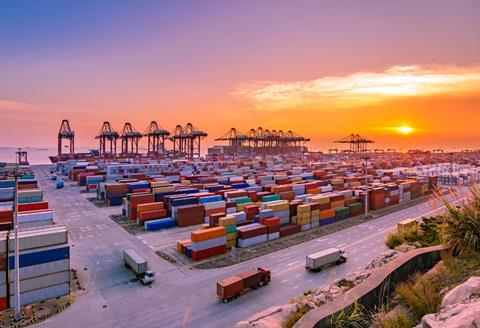Marine war insurance rates are “about level” between conflict zones in the Black Sea and the latest Red Sea hotspot, according to a meeting of the International Union of Marine Insurance (IUMI).
Marine insurers continue to support trade through threat areas in the Red Sea and the Black Sea, IUMI emphasised in its winter meeting in London.

IUMI noted a 50% reduction in commercial shipping traffic going through the Suez Canal, since the Houthi government in Yemen began attacks on shipping in the Red Sea in November 2023.
Gas carriers, vehicle carriers and container ships have seen the biggest drop in Red Sea traffic, according to IUMI, while some vessel types, such as bulk carriers and general cargo vessels, continue to take the route in greater numbers.
More than 30 attacks have taken place by mid-February, with at least a dozen ships struck by ballistic missiles and loitering munitions (kamikaze drones carrying explosives).
Attacks by the Iranian-backed Houthis are hitting the maritime trade artery between Asia and Europe, targeting merchant vessels as they transit a choke point in the Bab El Mandeb Strait.
“There is no reason to think there’ll be a withdrawal of cover by direct insurers. This is a sustainable situation as it stands,” said Neil Roberts, head of marine and aviation at the Lloyd’s Market Association and secretary of the Joint War Committee, representing London market marine war insurers.
“There has been one vessel seizure whereby we may be exposed to a loss of the Galaxy Leader [hijacked 19 November]…Other than that, insurers have been relatively unscathed, because damage to vessels has been relatively minor,” he said.
“While it carries on like that, I see no reason for the market not to function as it is now, geared to look after this kind of risk. If there were a pollution incident requiring expensive salvage, or if there were a number of losses, then that would move the dial in pricing terms, but I don’t see people withdrawing in the immediate term,” Roberts said.
What has changed dramatically is marine war risk insurance pricing for vessels in the southern Red Sea, which has reportedly more than doubled, on average, for vessels taking the route.
“Red Sea [pricing] is rising, up to a few weeks ago those rates were below the Black Sea, and now those are about level, I understand,” Roberts added.
Black Sea “confidence”
Ukrainian exports through the Black Sea, particularly of grain, have risen in recent months, with marine insurers and marine war insurance continuing to protect vessels taking a Ukrainian corridor coastal route to and from Odessa through the western Black Sea.
During the period that the Black Sea Grain Corridor agreement with Russia was in place, between August 2022 to August 2023, Frédéric Denèfle, president of IUMI, noted that there were more than 1,000 shipments for the equivalent of 30 million tons of grain.
“Since then, during the first phase of the second period, it was quite difficult to imagine any shipowner being confident to go there and pick up grain product to be shipped…No one knew exactly how Russia would react,” Denèfle said.
Since then, Russia has focused on hitting Ukrainian port infrastructure, rather than ships at sea, Denèfle noted, speculating that this was less of a “bad advertisement” for Russia rather than hitting merchant ships and their crews sailing under various flag states at sea.
“The Russians have been attacking the harbour facilities…we have at least two examples of vessel being hit while waiting to load. Despite this, Ukrainian authorities have been able to rebuild their loading facilities… and therefore the Ukraine export system has been kept on and shipping activity has coped with that and are ready to export and to be insured,” he said.
This, combined with Ukraine hitting Russian naval assets, and only a limited mining threat, has contributed to shipping volumes bouncing back, Denèfle explained.
“We heard recently that Ukraine was able to export more than 10 million metric tons of cargoes. We don’t know exactly how this was done, maybe it was shipped from Danube as well,” he said.
Insurers in recent months have been “ready to insure” vessels, cargo, and war risks, he noted.
“The shipping community has gotten more confident. This is why they were able to ship so much cargo through what they call the Ukrainian corridor, under the custody of the Ukrainian forces, which turns out to be correct,” Denèfle said.
Roberts added: “There is…Ukrainian persistence to get the prices down. As Frederick says, it’s operating almost as in peacetime at the moment.”
Panama Canal “restricted”
IUMI also reported on restricted movement through the Panama Canal due to low water levels causing a restriction on a vessel’s maximum draught from 50 feet to 44 feet. This has reduced daily transits to around 24 vessels from a norm of 34-36 vessels. Sailings are expected to decrease further to 18 vessels later this month.
The result is longer transit times as vessels are re-routed, with voyages further compromised by Red Sea events. The convergence of these two crises comes in advance of the export surge around the lunar new year shutdowns in Asia, according to IUMI.
On average, it costs $400,000, for a container vessel to transit the Panama Canal, “but with this additional items, it’s a lot more”, IUMI said.
Expected consequences may include a shortage of delivered goods, containers out of position, gridlock at freight handling terminals and congestion at ports, IUMI warned.
Berlin 2024: IUMI turns 150
IUMI’s annual conference is to be held in Berlin 15-18 September 2024, the association has announced.
This year, IUMI celebrates its 150th anniversary, reflected in its conference theme “Building on 150 years of enabling global commerce”.










No comments yet